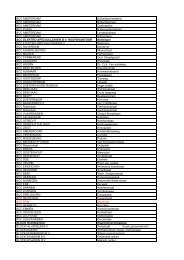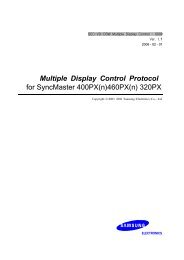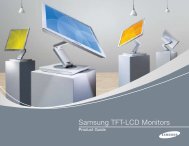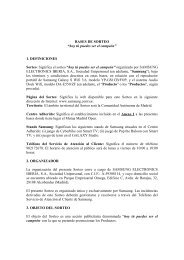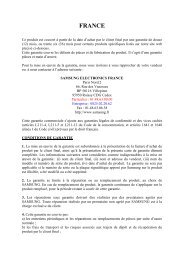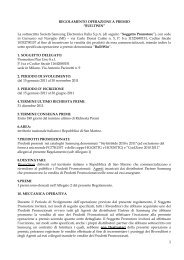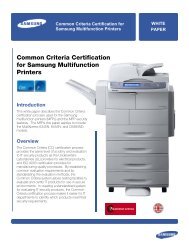2 / Samsung Electronics Sustainability Report 2012 /
2 / Samsung Electronics Sustainability Report 2012 /
2 / Samsung Electronics Sustainability Report 2012 /
You also want an ePaper? Increase the reach of your titles
YUMPU automatically turns print PDFs into web optimized ePapers that Google loves.
Scope 3 Emissions Management<br />
Scope 3 Emissions Management Process<br />
<strong>Samsung</strong> <strong>Electronics</strong>’ Scope 3 GHG emissions include GHG emissions associated with suppliers, product use, transport of parts and products and business<br />
travel by Korean employees.<br />
Supplier GHG emissions are calculated using the activity data submitted by suppliers. Emissions associated with logistics and business travel are automatically<br />
calculated by the G-EHS. GHG emissions associated with product use are estimated using energy consumption information and typical use<br />
scenarios for each product. The GHG emissions of product use are correlated to the energy effi ciency of products. The GHG emissions data of each scope<br />
can be managed by environmental managers in each division, the corporate environmental affairs management team, and top management.<br />
Boundary of Scope 3 Management<br />
Scope 3 GHG emissions are calculated as per related international standards including ISO 14064, IPCC guidelines, WBCSD Scope 3 guidelines and<br />
carbon footprint labeling standard of Korea.<br />
GHG Emissions in Product Use <strong>Samsung</strong> <strong>Electronics</strong> defi nes ”GHG Emissions associated with product use” as the amount of GHG emissions caused<br />
by electricity consumption of <strong>Samsung</strong> <strong>Electronics</strong> products. The emissions associated with product use have not increased despite an increase in the<br />
number of products sold due to the increased energy effi ciency of newer products. We achieved 17,630 thousand tons of GHG emission reductions in<br />
2011 compared to the 2008 levels.<br />
Improvement Rate of Product Energy Effi ciency (%)<br />
Target Actual<br />
7.7<br />
Raw material Parts Manufacturing Logistics Consumer use<br />
2009<br />
8.4<br />
15.7<br />
2010<br />
15.9<br />
Product Energy efficiency improvement rate = (2008 average power consumption–2011<br />
average power consumption) / (2008 average power consumption) × 100<br />
12 / <strong>Samsung</strong> <strong>Electronics</strong> <strong>Sustainability</strong> <strong>Report</strong> <strong>2012</strong> /<br />
23.1<br />
2011<br />
Employee business travel<br />
25.6<br />
GHG Emissions Reduction in Product Use (1,000 tons CO2)<br />
Target Actual Cumulative<br />
3,340<br />
4,440<br />
2009<br />
4,440<br />
8,350<br />
15,290<br />
2010<br />
10,850<br />
Target is made by 10% of annual increasing in product sales volume<br />
Scope: All consumer products sold globally (excluding parts)<br />
Disposal/<br />
recycling<br />
15,270<br />
32,920<br />
2011<br />
17,630



